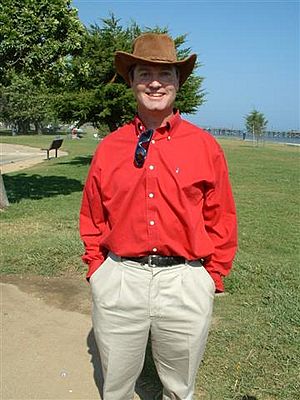Joseph Polchinski facts for kids
Quick facts for kids
Joseph Polchinski
|
|
|---|---|

Joe Polchinski in Santa Barbara, 2004
|
|
| Born |
Joseph Gerard Polchinski
May 16, 1954 White Plains, New York, U.S.
|
| Died | February 2, 2018 (aged 63) |
| Known for | D-branes Polchinski's paradox Firewall Everett phone |
| Awards | Dannie Heineman Prize for Mathematical Physics (2007) Dirac Medal (2008) Physics Frontier Prize (2013) Fundamental Physics Prize (2017) |
| Scientific career | |
| Institutions | University of California, Santa Barbara |
| Doctoral advisor | Stanley Mandelstam |
Joseph Gerard Polchinski Jr. (May 16, 1954 – February 2, 2018) was an American theoretical physicist and string theorist. He was famous for his important work in string theory, which is a way to understand the smallest parts of our universe. He made big discoveries, especially about something called D-branes.
Contents
About Joseph Polchinski
Joseph Polchinski was born in White Plains, New York, on May 16, 1954. He was the older of two children. His father, Joseph Gerard Polchinski Sr., worked as a financial consultant. His mother, Joan, was an office worker and homemaker.
Joseph Polchinski finished high school in Tucson, Arizona, in 1971. He then went to Caltech and earned his bachelor's degree in 1975. Later, he got his Ph.D. from the University of California, Berkeley in 1980. His main teacher there was Stanley Mandelstam. It's interesting that he didn't publish any research papers while he was a graduate student.
After finishing his studies, he worked at SLAC and Harvard for a few years. From 1984 to 1992, he was a professor at the University of Texas at Austin. Then, from 1992 until 2017, he taught physics at the University of California, Santa Barbara. He was also a permanent member of the Kavli Institute for Theoretical Physics there.
His Big Ideas in Physics
Joseph Polchinski wrote an important two-volume textbook called String Theory in 1998. He made many contributions to theoretical physics. His work on D-branes is probably the most famous.
He received several awards for his work. In 2008, he won the Dirac Medal for his discoveries in superstring theory. He also received the 2017 Fundamental Physics Prize for his contributions to theoretical physics.
What Are D-branes?
Polchinski's work on D-branes was a major step forward in string theory. It helped start what scientists call the 2nd superstring revolution. D-branes are special objects in string theory. Imagine strings, which are tiny vibrating lines of energy, making up everything. D-branes are like surfaces or "branes" where these strings can end.
In 1995, Polchinski suggested that D-branes were connected to other theoretical objects called black p-branes. This idea led to a concept called holography. Holography suggests that a theory of gravity in a higher dimension can be described by a simpler theory without gravity in a lower dimension. This idea was later shown in something called the AdS-CFT duality, which is a big deal in physics.
Polchinski's Paradox
Around 1990, Joseph Polchinski thought about a tricky problem related to time paradoxes. This problem is now known as Polchinski's paradox. It involves sending an object, like a billiard ball, through a wormhole that takes it back in time.
Here's the puzzle: Imagine you shoot a billiard ball into a wormhole. The wormhole sends it back in time. The ball then comes out of the wormhole in the past. It comes out at an angle that makes it crash into its younger self. This crash would knock the younger ball off course, stopping it from ever entering the wormhole in the first place. But if the younger ball never enters the wormhole, then the older ball wouldn't exist to crash into it! This creates a paradox.
Scientists later found ways to solve this paradox. They suggested that the ball might come out of the wormhole at a slightly different angle. This angle would cause it to just graze its younger self. This small hit would change the younger ball's path just enough so that it would still enter the wormhole and travel back in time to cause that exact glancing blow. It's a mind-bending idea!
Black Holes and New Ideas (2012)
In 2012, Polchinski and some of his students, along with another string theorist, Donald Marolf, published an important paper. Their calculations were about Hawking radiation, which is radiation that comes from black holes.
Their paper suggested something surprising. It seemed to show that either general relativity's equivalence principle was wrong, or a key rule of quantum mechanics was incorrect. This caused a lot of discussion among physicists about how black holes work and what happens at their edges.
Personal Life and Death
Joseph Polchinski was married to Dorothy Maria Chun in 1980. They had two sons, Steven and Daniel.
He passed away at his home in Santa Barbara, California, on February 2, 2018. He was 63 years old and died from brain cancer.
See also
 In Spanish: Joseph Polchinski para niños
In Spanish: Joseph Polchinski para niños

